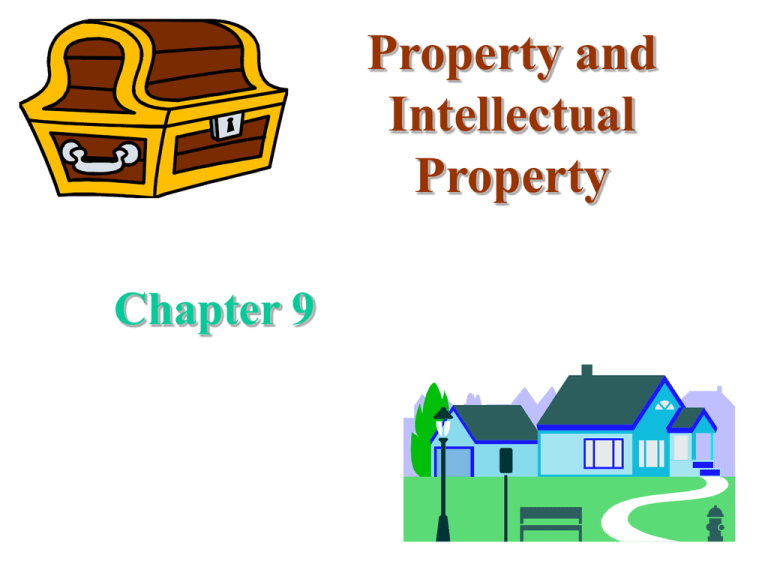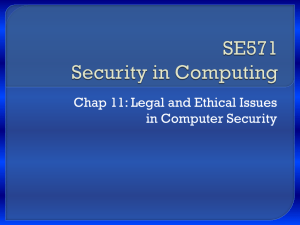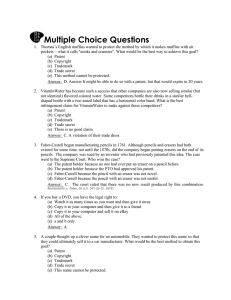ch09
advertisement

Property and Intellectual Property Chapter 9 Real Property • Land – under - oil, minerals – attached - buildings, trees,crops • Property - “legally protected expectation of being able to use a thing for one’s advantage.’’ Personal Property • Everything that is not real property. • Tangible – Essence of property is its physical existence. – Cars, trailers, furniture, equipment. • Intangible – Essence of property is the rights, not the physical existence. – Stocks, bonds, patents, copyrights, goodwill. Intellectual Property • Intangible property • Major forms include: – trademarks – trade names – copyrights – patents – trade secrets Copyright © • Registration simple—not a guarantee of validity • Works must be original • Life of author plus 70 years • Gives owner exclusive right to: – – – – – reproduce publish or distribute display in public perform in pubic prepare derivative works based on original Infringement and Fair Use in Copyright • Fair use - “for purposes such as criticism, comment, news reporting, teaching,…scholarship, or research” • Four Factors of “fair use” – purpose and character of copying – nature of work – extent of copying – effect of copying on market • Example--ok to copy TV show for personal use Patents • Exclusive right to make, use, • But expensive, technical and time-consuming or sell a product for 20 years process • Anyone who “invents or • Since patent divulges all discovers any new and info to competitors, some useful process, machine, prefer trade secrets manufacture, or • If Coca Cola had gotten a composition of matter, or patent instead of trade any new and useful secret it could be used by improvement thereof, may obtain a patent” others after 1907 • Strong protection during life of patent Richardson-Vicks v. Upjohn • RVI owned a patent, issued in 1985, for an OTC medicine for the relief of cough, cold, and flu symptoms. • Upjohn contested its validity because it was very similar to prior inventions and was for something obvious, but in 1992 the patent office upheld the patent. • RVI sued Upjohn for infringement for selling products that had the same formula as the patent. • The jury held for RVI and awarded it a royalty of 7%. The judge overturned the jury verdict, and RVI appealed . • HELD: The appeals court affirmed the trial judge’s ruling. • The product formulation (2 ingredients of ibuprofen & pseudoephedrine) would have been obvious to one of ordinary skill in the art; patent invalid. Want to Hear My Songs? Pay Up by Ted Nugent • Issue: Is Copying Music Acceptable? • People copy music files by burning CDs or downloading from the web without paying • The music industry is attempting to upgrade the quality of music and also protect intellectual property rights • The 9th Circuit Court of Appeals ruled that Napster had to stop providing unauthorized music • But downloading music files is very difficult to stop Trademark • A commercial symbol – design, logo, distinctive mark, name or word – “brand name” – protected by common law & the Lanham Act – classified (see also Exhibit 9.1) • arbitrary and fanciful (most favored) • suggestive (not as favored--but Chicken of the Sea is okay) • descriptive (less favored--but Holiday Inn and Bufferin have protection) • generic—not protected, eg. Trampoline, nylon, thermos, shredded wheat, zipper, aspirin. • Note Xerox, Proctor and Gamble Harley-Davidson, Inc. v. Grottanelli • Grottanelli owns The Hog Farm, a motorcycle repair shop in NY. He used “hog” in connection with events he sponsored and products he sold. He also used variants of the Harley’s bar-andshield logo. • Harley sued to enjoin Grottanelli from using the word “hog” and from using the bar-and-shield logo. The district court held for Harley; Grottanelli appealed. • Grottanelli was using the word “hog” when Harley was trying to disassociate itself from the word. Other facts also supported the claim that the word was a generic term long before Harley registered the word in 1987. • HELD: Harley could not prohibit Grottanelli from using the word “hog,” but did prohibit him from using variations of the bar-andshield logo. Other Marks • Service Marks • Trade Dress – Apply to services, not – Concerns the “look goods and feel” of products – Law is the same as for and service trademarks establishments. – Ex: International – Size, shape color, Silk Assn. uses the texture, graphics, etc. motto: “Only silk is – Must be “inherently silk.” distinctive” – Ex: Burger King’s “Home of the – Two Pesos v. Taco Whopper” Cabana: One Mexican restaurant could not copy its competitor’s decor Trade Secrets • Coca-Cola has held secret the formula for Coke for over 100 years; so protection can be strong. • Kentucky Fried Chicken recipe. • Most trade secret lawsuits are common law actions of stealing & using secrets • Prosecutors can also press criminal charges • Protection in other countries is difficult • Information is a trade secret if: – it is not known by the competition – business would lose advantage if competition were to obtain it – owner has taken reasonable steps to protect the secret from disclosure Buffets, Inc. v. Klinke • Old Country Buffets (OCB) developed “small-batch cooking” to ensure freshness. The Klinkes fraudulently obtained a copy of OCB’s recipes and its EE manual. • The Klinkes opened Granny’s at which they used the OCB EE manual and recipes. OCB sued for trade secret theft. • The district court granted summary judgment for Klinkes. • HELD: The appeals court stated that the alleged secrets were so obvious that very little effort would be required to “discover” them. • “Klinkes may be liable for stealing something, but not . . . misappropriation of trade secrets. . . .” New York Times Co.v. Tasini (2001) © • Tasini and other freelance authors wrote articles for NY Times Company. Authors registered copyrights in articles. Each Times magazine and newspaper then registered collective work copyrights. • Times allowed LEXIS/NEXIS to publish the works online. • Authors sue Times for copyright infringement as they did not give permission for online publication. Times said it had the right to reproduce the works. District Ct. held for Times; Appeals Court held for the authors; Times appealed to the U.S. Supreme Court. • HELD: Affirmed. Both Times and LEXIS/NEXIS infringed. • Section 201 (c) of the Copyright Act states that a “separate contribution to a collective work is distinct from . . . the collective work, and vests initially in the author of the contribution.” • Publishers may make agreements for electronic reproduction. • LEXIS infringed in publishing without permission; Times infringed by authorizing and aiding LEXIS in placing articles in their databases.





